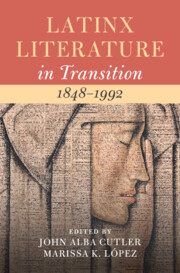Book contents
- Latinx Literature in Transition, 1848–1992
- Latinx literature in transition
- Latinx Literature in Transition, 1848–1992
- Copyright page
- Dedication
- Contents
- Figures
- Contributors
- Acknowledgments
- Introduction
- Part I Space
- Chapter 1 José Garcia Villa’s Sojourn in New Mexico
- Chapter 2 Latinx Internationalism, French Orientalism, and a Nuyorican Morocco
- Chapter 3 Centro America in San Francisco
- Chapter 4 Bridges, Backs, and Barrios
- Part II Being
- Part III Time
- Part IV Form
- Part V Labor
- Bibliography
- Index
- References
Chapter 4 - Bridges, Backs, and Barrios
Radical Women of Color Feminisms and the Critique of Modern Space
from Part I - Space
Published online by Cambridge University Press: 10 April 2025
- Latinx Literature in Transition, 1848–1992
- Latinx literature in transition
- Latinx Literature in Transition, 1848–1992
- Copyright page
- Dedication
- Contents
- Figures
- Contributors
- Acknowledgments
- Introduction
- Part I Space
- Chapter 1 José Garcia Villa’s Sojourn in New Mexico
- Chapter 2 Latinx Internationalism, French Orientalism, and a Nuyorican Morocco
- Chapter 3 Centro America in San Francisco
- Chapter 4 Bridges, Backs, and Barrios
- Part II Being
- Part III Time
- Part IV Form
- Part V Labor
- Bibliography
- Index
- References
Summary
Edited by two Chicana lesbian feminists and formed through commitment to coalitional Third World feminist analysis and practice, This Bridge Called My Back urges us to attend to the conflicts and pleasures that emerge from the radical transformation of the self in relation to others as we struggle for liberation. In the forty years since the anthology’s original publication, we continue to bear witness to the destructive outcomes of neoliberalism and to those who are still consigned to disproportionately bear the brunt of modernity’s violence. We are compelled to address the betrayals of those spaces of solidarity and the use of violence to reclaim difference as an amenity of traditional power. Making domination “make sense” often occurs by recruiting representatives of subordinated populations into normative locations of institutional power. The tokenized investment in women of color as fixed symbols of progressive politics illustrates how even the celebration of racial difference can function as a technology of racist power. I argue that bridge building is also about place making or the radical vision of a space for new social relations and terms of recognition. Radical methodologies for creating art participate in this process of gathering political will to oppose racial power.
Keywords
- Type
- Chapter
- Information
- Latinx Literature in Transition, 1848–1992 , pp. 73 - 92Publisher: Cambridge University PressPrint publication year: 2025

